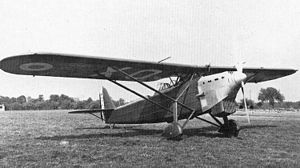
The Amiot 143 was a 1930s French 5-seat Multiplace de Combat (M.5) designed to meet 1928 specifications for a monoplane capable of day and night bombing, long-range reconnaissance and bomber escort.

The Koolhoven F.K.58 was a single engine, interceptor-fighter aircraft designed and mainly manufactured by N V Koolhoven in the Netherlands under contract by France. Intended for Armée de l'Air use, the F.K.58 saw limited service in the Battle of France.

The Farman F.220 and its derivatives were thick-sectioned, high-winged, four engined French monoplanes from Farman Aviation Works. Based on the push-pull configuration proven by the F.211, design started in August 1925 and the first flight of the prototype was on 26 May 1932. The largest bomber to serve in France between the two world wars was the final F.222 variant. One variation was intended to be an airliner.

The Dornier Do 22 was a German seaplane, developed in the 1930s. Despite good performance, it was built only in small numbers and entirely for the export market. The type was operated in the Second World War by Finland, Greece and Yugoslavia.

The Dewoitine D.27 was a parasol monoplane fighter aircraft designed by Émile Dewoitine in 1928.
The Letov Š-16 was a Czechoslovak single-engined, two-seat biplane bomber. It was designed by Alois Šmolík at Letov Kbely. The Š-16 first flew in 1926.

The Morane-Saulnier M.S.225 was a French fighter aircraft of the 1930s. It was produced in limited quantities to be used as a transitional aircraft between the last of the biplanes and the first monoplane fighters.
The Potez XV was a French single-engine, two-seat observation biplane designed as a private venture by Louis Coroller and built by Potez and under licence by Podlaska Wytwórnia Samolotów and Plage i Laśkiewicz in Poland.

The CAMS 30E was a two-seat flying boat trainer built in France in the early 1920s. It was the first aircraft designed for CAMS by Raffaele Conflenti after he had been recruited by the company from his previous job at Società Idrovolanti Alta Italia (SIAI). It was a conventional design for the era featuring a two-bay equal-span unstaggered biplane wing cellule. The prototype was exhibited at the 1922 Salon de l'Aéronautique and evaluated the following year by the Aéronautique Maritime. The type's favourable performance led to an order of 22 machines for the French military and an export order of seven for Yugoslavia and four for Poland.

The Potez 540 was a French multi-role aircraft of the 1930s. Designed and built by Potez, it served with the French Air Force as a reconnaissance bomber, also serving with the Spanish Republican Air Force during the Spanish Civil War. Although obsolete as a bomber, it remained in service in support roles and in France's overseas colonies at the start of World War II.

The Dewoitine D.1 was a French single-seat fighter aircraft of the 1920s, built by the French industrial company Dewoitine.

The Potez 452 was a French flying boat designed and built by Potez in response to a French Navy specification for a shipboard reconnaissance machine for use on its battleships and cruisers.

The Dewoitine D.21 was 1920s French open-cockpit, fixed-undercarriage, parasol winged monoplane fighter aircraft.
The Donnet-Denhaut flying boat was a maritime patrol and anti-submarine warfare aircraft produced in France during the First World War. Known at the time simply as "Donnet-Denhaut" or "DD" flying boats, the DD-2, DD-8, DD-9, and DD-10 designations were applied retrospectively to denote the various changes in configuration made during their service life.

The FBA 17 was a training flying boat produced in France in the 1920s.

The Potez 39 was a twin-seat single-engined parasol wing monoplane aerial reconnaissance and observation aircraft designed and produced by the French aircraft manufacturer Potez. It was the company's first all-metal aircraft.

The Wibault 7 was a 1920s French monoplane fighter designed and built by Société des Avions Michel Wibault. Variants were operated by the French and Polish military and built under licence for Chile as the Vickers Wibault.

The Bréguet 410 was a French bomber of the early 1930s. Not many of these twin-engined sesquiwing biplanes were built. At least one Breguet 413, one of its variants, was sold to the Spanish Republican Air Force during the Spanish Civil War.

The Blériot-SPAD S.91 was a French light-weight fighter aircraft. It would be later developed into the Blériot-SPAD S.510, the last biplane produced by the French aeronautic industries.

The Les Mureaux 3 C.2 and Les Mureaux 4 C.2 were French two seat, parasol winged fighters, flown in 1927-8, which differed only in their engines. They were developed into near identical army co-operation types, the ANF Les Mureaux 130 A.2 and ANF Les Mureaux 131 A.2, in 1929–31.



















